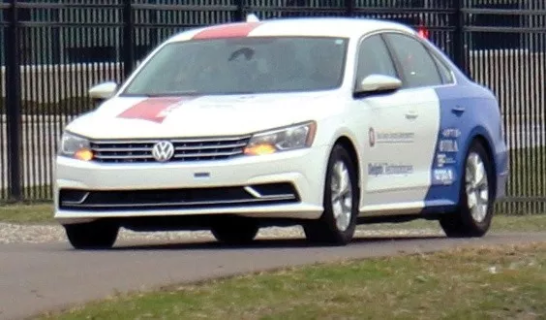 德尔福智能驾驶系统帮助 9 名未经过专业驾驶训练的记者平均降低了16% 的燃油消耗,但完成相同路线的时间仅小幅增加了 4%。
德尔福智能驾驶系统帮助 9 名未经过专业驾驶训练的记者平均降低了16% 的燃油消耗,但完成相同路线的时间仅小幅增加了 4%。 德尔福的新型推进控制器 —— 中央电子控制单元(ECU),可实现智能驾驶(Intelligent Driving)并与其他车载系统以及外部世界的通上。
德尔福的新型推进控制器 —— 中央电子控制单元(ECU),可实现智能驾驶(Intelligent Driving)并与其他车载系统以及外部世界的通上。
“这世界上的大多数人,可能都不算真正会开车” — 德尔福公司虽未直说,但他们推出的新技术表达的就是这个意思。近日,德尔福工程师表示,公司最新推出的“Intelligent Driving”智能驾驶技术可以将各类车辆的燃油经济性平均提高 10% 以上。
这款智能驾驶系统是德尔福公司在 2019 年拉斯维加斯 CES 消费电子展上的王牌产品。该系统将公司的顶尖推进系统组件与自动驾驶技术相结合,可“预判”前方道路状况并及时调整车辆操作,从而提高车辆的燃油经济性。很显然,与对前方道路毫不知情的人类驾驶员相比,对前方道路状况“了如指掌”的智能驾驶系统可以更加合理地规划燃料使用,避免浪费燃料的情况。
全新推进组件,全新信息协作方式
智能驾驶系统的核心是一个“无所不知”的全新组件:“推进器控制器”。这个控制器可以用于整理并评估来自各种车辆现有电子控制单元(ECU)的信息,例如发动机控制器、变速器控制器,及越来越多的推进系统控制器(比如电机控制器、电池控制器和混合动力系统控制器等)。
推进系统控制器是车辆联系外部世界的纽带,可以从车辆“视觉”传感器(如摄像头、雷达和激光雷达)获取数据,并与“车辆到基础设施网络(V2I)”、“车辆到车辆网络(V2V)”及目前正在建造中的服务于自动驾驶汽车的云信息系统进行通信。这些信息对于帮助推进系统控制器预判前方道路状况至关重要:比如,交通信号灯可能马上就要变红灯,下个转弯可能路边停了很多车辆等。
智能驾驶系统的使用方式与“自适应巡航”等车辆功能类似,可以根据自身对前方道路的预判实时调整车速。举例来说,系统可通过一些精密地图软件了解到前方不远处将出现一座小山,因此会稍微提高车速以避免变速器降档;或者减少燃料供给,确保变速器在降档前不会浪费燃油。
德尔福工程师表示,在一些已经在交通信号灯和停车标志中配备了传感器的交通拥堵路段,车辆在配备智能驾驶系统后可以更加充分地利用交通基础设施信息,从而避免走走停停的情况,大大改善车辆的燃油经济性,并缓解交通拥堵状况。毫无疑问,交通拥堵是全球几乎所有大城市的通病,因此智能驾驶系统的出现将市民的日常出行带来很大益处。
智能行驶,绝不浪费
德尔福首席技术官 MaryGustanski 承认,她本人最初也对这个系统持怀疑态度。因此,Gustanski 决定亲自试试智能驾驶系统的效果:她驾驶一辆试验车在同一条测试线路上跑了两遍,第一遍未使用智能驾驶系统,第二遍使用了智能驾驶系统。
“我本来认为肯定是我开的更好,”Gustanski 表示,但情况并未如此。Gustanski 的驾驶技术值得肯定,一路都非常平稳,但智能驾驶技术还是让她的驾驶效率有所提高。
“每个人都可以从智能驾驶系统中受益,”Gustanski 告诉《汽车工程》,“这还能让我们做好准备,迎接自动驾驶汽车的到来。”
在密歇根州的试车场内,与 Gustanski 一样,记者们在亲自上车体验前也对智能驾驶系统将信将疑。“开慢点、省点油”,这个所谓的智能驾驶系统不就是这回事吗?更何况,对于很多人来说,开车慢吞吞是绝对无法接受的。但情况并非如此。
在密歇根州弗林特市凯特林大学的一条小型测试道路上,共有 9 名记者亲自体验了德尔福的智能驾驶系统。他们首先在不使用智能驾驶系统的情况下开了一遍,然后在使用智能驾驶系统的情况下又开了一遍同样的线路。德尔福先进动力总成系统工程经理 Keith Confer 表示,智能驾驶系统帮 9 名未经过专业驾驶训练的记者平均降低了 16% 的燃油消耗,但完成相同路线的时间仅小幅增加了 4%。
事实上,智能驾驶系统帮本文作者降低了 20%的燃油消耗,而且完成大约 2.5 分钟路线的时间仅增加了短短2 秒。
无需等待,立刻享受
智能驾驶系统是“已经成熟,”Gustanski 表示,“德尔福正在说服公司的OEM 客户准备推进系统控制器。”目前,德尔福也已经开始生产推进系统控制器;Gustanski 说,只要推进系统控制器的成本可以降下来,所有车辆都可以得益于智能驾驶系统,无论是传统动力汽车、混合动力汽车,还是全电动汽车。
德尔福工程师承认,在使用智能驾驶系统后,驾驶员的行为还需要进行一些调整。最重要的是,正如当今的自适应巡航系统一样,驾驶员也必须在城市驾驶环境中更加习惯于使用智能驾驶系统。
对于一些通常只在高速公路上使用巡航控制系统的人来说,这可能有些陌生。至少就目前而言,智能驾驶系统并不能控制车辆制动,只能控制油门的使用。
Gustanski 表示,与一些商用卡车中已经使用的动力总成控制系统不同,智能驾驶系统的应用“更加广泛,也更加深入。这其中的差别可能只在信息,但我们现在还需要进行大量开发,获得更多数据”。
Delphi Technologies isn’t coming right out to say most of us aren’t very good at driving efficiently, but there’s no getting around that’s what’s implied by the company’s new Intelligent Driving technology, which its engineers said can improve the fuel economy of just about any vehicle by 10% or more when the system is engaged.
The Intelligent Driving system, slated as the centerpiece of Delphi’s presence at the 2019 CES in Las Vegas, mixes cutting-edge Delphi propulsion-system components with enabling technology for automated driving to deliver a system that uses autonomous functionality to “predict” the road ahead. If the vehicle— and its propulsion system—know what’s coming up, it can avoid using fuel that the driver, without knowledge of the road ahead, would unknowingly waste.
New propulsion component, new information collaboration
Key to the Intelligent Driving system is an all-new, all-knowing component: a “propulsion controller” that collates and evaluates the information from a variety of existing vehicle electronic control units (ECUs) such as the engine and transmission controllers—and increasingly, ECUs governing electrified propulsion systems such as motor-generators, batteries and entire hybrid-electric drivetrains.
The propulsion controller is the vehicle’s link to the outside world. It takes in data from “vision” sensors such as cameras, radar and lidar and, crucially, communicates with the vehicle-to-infrastructure (V2I) and vehicle-to-vehicle (V2V) networks and cloud-information systems currently being built out to serve autonomous vehicles. This information is vital to helping the propulsion controller understand what’s ahead: maybe a traffic light ready to turn red, perhaps a long line of stopped vehicles just around the next curve.
Using this advance awareness, the Intelligent Driving system is engaged by the driver in essentially the same fashion as adaptive cruise control. It controls the pace of the vehicle based on what is known about the upcoming route. Information from more-sophisticated mapping software, for example, can help the system know when a hill is looming, slightly adding speed to avoid transmission downshifting, or applying less throttle just before the vehicle descends a grade, lessening the need for energy-wasting braking.
Flow in heavy-traffic corridors with sensor-equipped traffic lights and stop signs, all communicating with vehicles equipped to make use of that information, could be greatly improved, Delphi engineers said, easing the stop-and-go pace that is such a fuel-wasting daily routine in nearly every city and town.
Pace without waste
Delphi CTO Mary Gustanski admitted she initially needed convincing. She drove a test car on a fixed route, first without Intelligent Driving, then with the system engaged.
“I was sure I’d done it better,” she insisted. But such was not the case; Intelligent Driving improved her efficiency, even though while driving without the system she was highly attuned to driving as smoothly and frugally as possible.
“This is something that can be done to help everyone on the road today,” she told AVE. “And then be ready for (the autonomous) tomorrow.”
Reporters preparing to try Intelligent Driving on a closed course in Michigan were dubious. It sounds like a fancy twist on the simple practice of “Slow down and save gas.” And many of us don’t embrace the idea of slowing down.
Nine press members drove the Intelligent Driving test car at a small track at Kettering University in Flint, Michigan, each with Intelligent Driving disabled, then a second drive on the same course with the system activated. On average, Intelligent Drive cut fuel consumption by 16% “while showing only about 4% longer time to complete the route,” said Keith Confer, Delphi’s engineering manager for advanced powertrain systems.
This author’s individual test saw fuel economy improved by 20% and the time to complete the roughly 2.5-minute course increase by just two seconds.
No waiting for the ‘future’
Intelligent Driving is “something that can be done now,” said Gustanski of the system’s readiness. “What Delphi is trying to talk [its OEM] customers into doing is putting a propulsion controller in place,” she added. Delphi is producing propulsion controllers now; once the cost of that component is absorbed, any vehicle, whether it’s conventionally-powered, hybrid or fully electric, can reap the benefits of the Intelligent Driving technology, Gustanski said.
Delphi engineers admit there will be some behavioral adaptation required as Intelligent Driving is adopted. Most importantly, drivers will need to become more accustomed to engaging the system—which effectively behaves like today’s adaptive cruise control—in around-town driving.
That may be somewhat foreign to those who typically view cruise control as an open-road feature. And at least for now, Intelligent Driving does not control vehicle braking, only how the throttle is used.
Not unlike some powertrain-control systems already in place in commercial trucks, Gustanski said use of Intelligent Driving for commercial vehicles could be “a broader and deeper” application of the technology. “Part of it is just knowledge,” she said. “We have a lot of development to go and a lot of data to develop.”
Author: Bill Visnic
Source: SAE Autonomous Vehicle Engineering
等级
打分
- 2分
- 4分
- 6分
- 8分
- 10分
平均分
